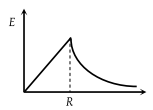Three charges –q1, +q2 and –q3 are placed as shown in the figure. The x-component of the force on –q1 is proportional to

(1)
(2)
(3)
(4)

Two-point charges \(+q\) and \(–q\) are held fixed at \((–d, 0)\) and \((d, 0)\) respectively of a \((x, y)\) coordinate system. Then:
| 1. | \(E\) at all points on the \(y\text-\)axis is along \(\hat i\) |
| 2. | The electric field \(\vec E \) at all points on the \(x\text-\)axis has the same direction |
| 3. | The dipole moment is \(2qd\) directed along \(\hat i\) |
| 4. | The work has to be done to bring a test charge from infinity to the origin |
A point charge of \(40~\text{stat coulomb }\)is placed \(2~\text{cm}\) in front of an earthed metallic plane plate of large size. Then the force of attraction on the point charge is
1. \(100~\text{dynes}\)
2. \(160~\text{dynes}\)
3. \(1600~\text{dynes}\)
4. \(400~\text{dynes}\)
Four charges equal to – Q are placed at the four corners of a square and a charge q is at its centre. If the system is in equilibrium the value of q is
1.
2.
3.
4.
Which of the following graphs shows the variation of electric field E due to a hollow spherical conductor of radius R as a function of distance from the centre of the sphere
| 1. |  |
2. |  |
| 3. |  |
4. |  |
(1)
(2)
(3)
(4)
The electric field due to a uniformly charged solid sphere of radius R as a function of the distance from its centre is represented graphically by -
(1) 
(3) 
Two concentric conducting thin spherical shells \(A\) and \(B\) having radii \(r_A\) and \(r_B\) \((r_B>r_A)\) are charged to \(Q_A\) and \(-Q_B~(|Q_B|>|Q_A|).\) The electrical field at distance \(x\) from the common center is:
| 1. |  |
2. |  |
| 3. |  |
4. |  |
The electric field inside a spherical shell of uniform surface charge density is -
1. Zero
2. Constant, less than zero
3. Directly proportional to the distance from the centre
4. None of the above
The distance between charges 5 × 10–11 C and –2.7 × 10–11 C is 0.2 m. The distance at which a third charge should be placed in order that it will not experience any force along the line joining the two charges is
1. 0.44 m
2. 0.65 m
3. 0.556 m
4. 0.350 m
Suppose the charge of a proton and an electron differ slightly. One of them is \(\text- e\) and the other is \((e+\Delta e)\). If the net of electrostatic force and gravitational force between two hydrogen atoms placed at a distance \(d\) (much greater than atomic size) apart is zero, then \(\Delta e\)
1. \(10^{-20}~\text{C}\)
2. \(10^{-23}~\text{C}\)
3. \(10^{-37}~\text{C}\)
4. \(10^{-47}~\text{C}\)












